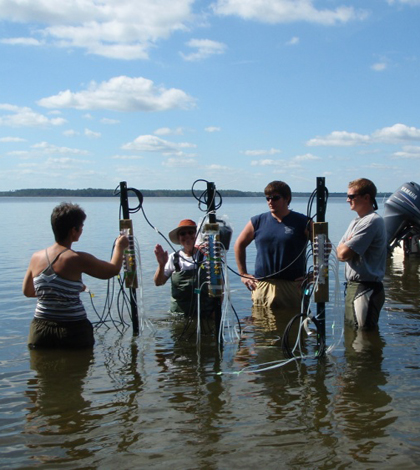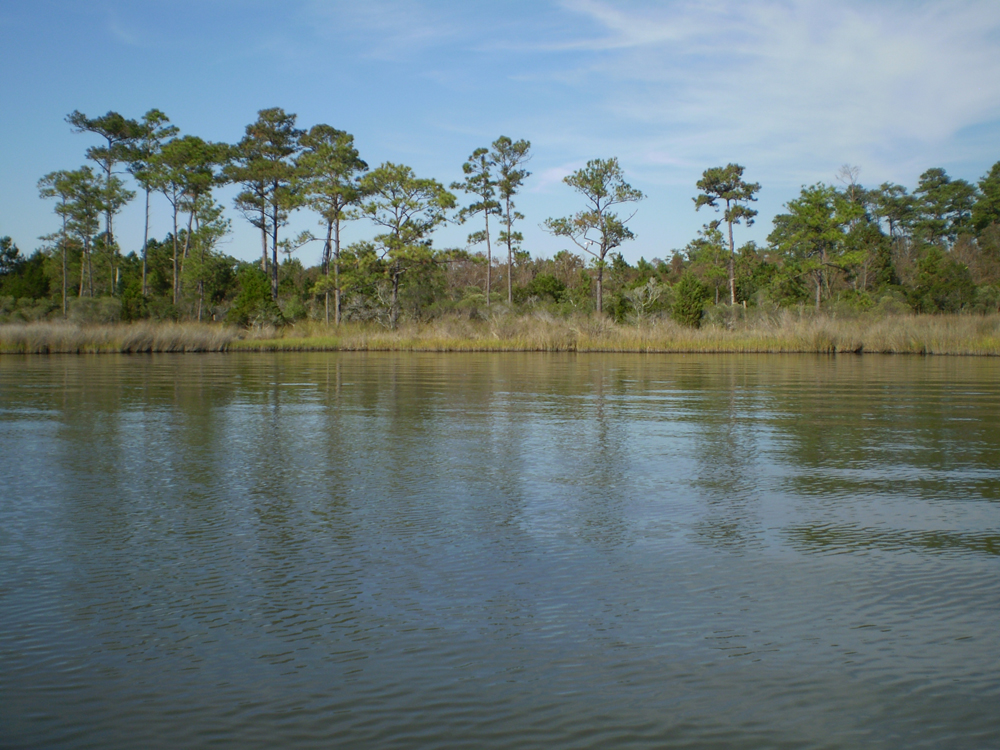Study peers into workings of shallow estuary

A Research team including Anderson takes field measurements on the New River Estuary (Credit: NOAA)
Shallow estuaries are common along the U.S. East Coast, but they haven’t seen as much attention from scientists as the big, deep estuaries like Chesapeake Bay.
“There’s not that much data on these shallow systems, which behave completely differently than deep estuaries,” said Iris Anderson, professor of marine science with the Virginia Institute of Marine Science.
A recently published study led by Anderson on a North Carolina estuary should help untangle a complicated web of environmental drivers and processes that make shallow estuaries tick. The research could also help scientists project how the systems will react to the increased temperatures and storminess that climate change is predicted to bring to the region.
The New River, the setting of the study, flows through southeastern North Carolina for 50 miles before widening into an estuary that winds past Marine Corps Base Camp Lejeune and empties into the Atlantic Ocean. The Department of Defense is concerned about the effects of its bases on coastal resources, Anderson said. It’s important that in the course of carrying out their functions like military training, they’re not violating environmental laws like the Clean Water Act.
To gauge the base’s activities and the health of the New River Estuary, the department funded research from Anderson and other researchers on how the system functions. They’ve committed to ten years of funding. The first five-year cycle focused on nutrients and came to a close in January. A portion of the results were recently published in the journal Estuaries and Coasts. The next five years will focus on carbon.
“It’s an unusual opportunity to learn a lot about a system,” Anderson said. Much more than most people ever get the opportunity to do.”

Marine Corps Base Camp Lejeune conducts military training exercises around the estuary (Credit: VIMS)
Though the research will have practical implications for the military, it will also have broad scientific applications for how scientists understand shallow estuaries. Despite their prevalence along U.S. and European coasts, the systems have been relatively poorly studied compared with their deeper counterparts.
Deep and shallow estuaries differ greatly in how they handle ecosystem functions like nutrient processing. When a nutrient like nitrate enters a deep estuary like Chesapeake Bay, it can be detected in the water column where it fuels phytoplankton production. On the other hand, shallow estuaries receiving a similar amount of nitrate don’t see as much nitrate hanging around in the water column as would be expected based on their understanding of deep estuaries.
The difference is light, which penetrates the shallow waters and drives photosynthesis in microorganisms that sequester nutrients on the bottom. That’s the heart of it, but there’s a lot more going on around that process that either helps move it along or threatens to overmatch it.
It’s a complex web of causes and effects, and Anderson’s research has been an effort to tease apart the strands. She’s asking questions like, What are the processes that take up these nutrients, and how do they compare with competing processes that generate nutrients? And how do environmental factors like wind, temperature and freshwater discharge change those processes?
To find answers, she and her colleagues embarked on years of data collection in the to understand the fate of nutrients in the estuary by characterizing the sediment, water quality and weather patterns in the system.

New River Estuary (Credit: VIMS)
The results show that freshwater discharge into the estuary is among the most significant influences on how benthic microorganisms process nutrients. One reason for that is the colored dissolved organic matter brought into the estuary on riverine flows. The organic matter darkens the water, reducing the amount of light that reaches the bottom and reducing the productivity of the benthic photosynthetic organisms and their capacity to sequester nutrients.
But at the same time, freshwater discharge also brings in more nutrients, which generally boost productivity. The system is full of these opposing effects, and the researchers are developing mathematical models to more thoroughly represent their relative strengths.
The models will also help predict how the system will react to climate change. Climate scientists have projected increased storminess for the Mid-Atlantic region, and the models will be able to estimate the effects of the greater freshwater discharge and wind events that come along with that.
As for the practical applications for the military, Anderson said their data show that light is the overwhelming factor that determines the balancing acts between the estuary’s processes.
“We made it clear: It’s important that they reduce disturbance of the bottom a much as possible because we don’t want to stir it up and increase these total suspended solids and reduce light availability to the bottom,” Anderson said.
Anderson said that their results can likely be generally applied to other shallow systems, which could help alleviate the shortage of research. Though for Anderson’s part, it’s not just the lack of data on shallow estuaries that keeps her studying there.
“I’m really short, so I like shallow places where I can walk around,” Anderson said.
Top image: A research team including Anderson takes field measurements on the New River Estuary (Credit: NOAA)




0 comments